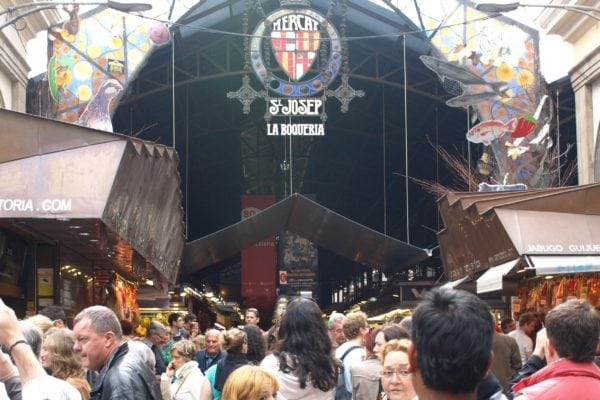PHOTOS
Food Instagrams Get the Pete Wells Treatment
Everyone loves to hate on Instagram images of restaurant food, including New York Times restaurant critic Pete Wells. Last week, his column reflected his view on the topic, saying not much we haven’t heard before. (Though there were a few great lines: “Not for the first time, I wondered: Am I supposed to eat this or take its picture?” is my favorite.)
The column touches on a few larger trends that, I’m happy to say, this humble newsletter has introduced. The speed at which trends spread around the world (see: cronuts, kale), for example. And then there’s the free marketing: “Chefs who serve camera-ready plates find their dining rooms full of volunteer publicists, who work for free and leave money on the table when they go home.”
Perhaps most interesting, the critic claims that composed photos of dishes are changing the way we eat: plates are made to look pretty and taste becomes second in importance. It’s even changed the layout of the commercial kitchen, with more space devoted to plating food than ever before.
I don’t know that this is all in direct response to food photography, but it certainly could be. At the end of the day, though: “When we taste something spectacular, we still want to take its picture. I hope chefs can remember that, or we’ll all have to get used to eating things that our mouths will never like as much as our cameras do.” Well-said.
HMM
Do Phones Really Cause Slower Restaurant Service?
By now you’ve seen or heard about the Craigslist posting from one anonymous restaurant detailing how smartphones have changed restaurant service over the past decade. The original Craigslist post has been deleted, but if you missed it, Distractify has the full text.
As the post spread, plenty of people wondered if it was actually real. I, like Andreessen-Horowitz’s Marc Andreessen, believe parts of this are bogus, but is almost certainly rooted in at least some fact. Yes, a whole lot of diners pull their phones out during service at a restaurant, and its possible that this causes us to pay a bill slower, or take longer to order (googling obscure ingredients, perhaps?). But the same outlets reporting on this “study” or whatever it was also talk about larger shifts in the culture of dining out. Namely, that the restaurant experience itself has become the night’s destination, not just a stop on the way. In other words, dinner-and-a-movie is out; dinner-as-a-destination is in. (Eater has a great recap of the post, too.)
The bottom line: it is 100 percent possible that the ubiquity of and the way we use smartphones keeps us at restaurants longer. It’s also possible that we experience restaurants differently, treating them as a destination and enjoying the time spent lingering over a meal. Great restaurants spend lots of money on design and aesthetics and lighting and all of the things that make the space pleasing and comfortable; who wants to dash in and out of a pleasing, comforting space? This post will likely continue to spread far and wide, so I’m hopeful that its original author will give more detail about the included “findings.”
RUMOR ALERT
Will Square Acquire Caviar?
According to the internet, mobile payment company Square is in talks to acquire Caviar, a “curated food delivery company.” (Sigh.) Basically, Caviar works with hot and desirable restaurants in several US cities to deliver delicious restaurant meals that would be otherwise available only at the restaurant. The service itself is great, and restaurants from New York’s Mission Chinese to San Francisco’s AltaCAuse Caviar. The premise is simple: order online, get food delivered. (Its ordering for groups feature is especially useful, too.)
Why Square? As TechCrunch speculates, it may be time to get into the food delivery game. Square Order, launched in May, allows customers to place order online, but they have to physically go to the restaurant to pick up their food. Acquiring a company with a whole lot of experienced delivery drivers isn’t a bad idea. (It’s a good one.) So far, these rumors are only rumors, so stay tuned for updates.
SMART
On Food Hubs
Using digital technology to bring the best food to the most people: sounds like an excellent use of resources to me. Meet the “food hub,” an aggregator of different small food producers in one place. (Think: Good Eggs, for example.)
Last week, SF Weekly published a great piece on several of these hubs and the ripples of change they’re able to create. The piece is worth a read, so I won’t give away the farm here. Think of them as digital, large-scale farmer’s markets for high-quality products, from produce to baked goods to meat. These models help producers distribute their food, so the farmer can worry about the food, not marketing and distribution and all of the other necessary parts of the business that take away from the (very important) task at hand.
As food + technology goes, these food hubs are some of the best examples of how all of this technology can be used for so much good. More like this, please.
Digestifs
- Awesome, NYT Best-Selling illustrator seeks awesome chef tattoos for her next book —@wendymac
- How food data is personalizing the feedback loop — Food+Tech Connect
- Meet Lish, a new on-demand food delivery service in Seattle — GeekWire
- Things I want to go to: A 3D printed dinner party from ReImagine Food — Gizmag


